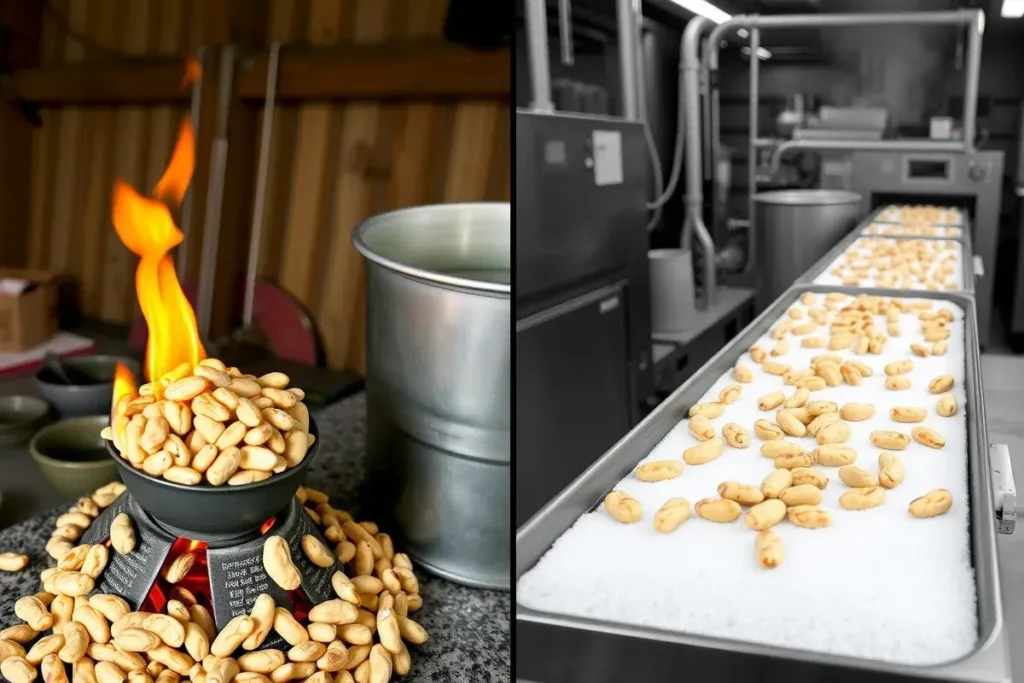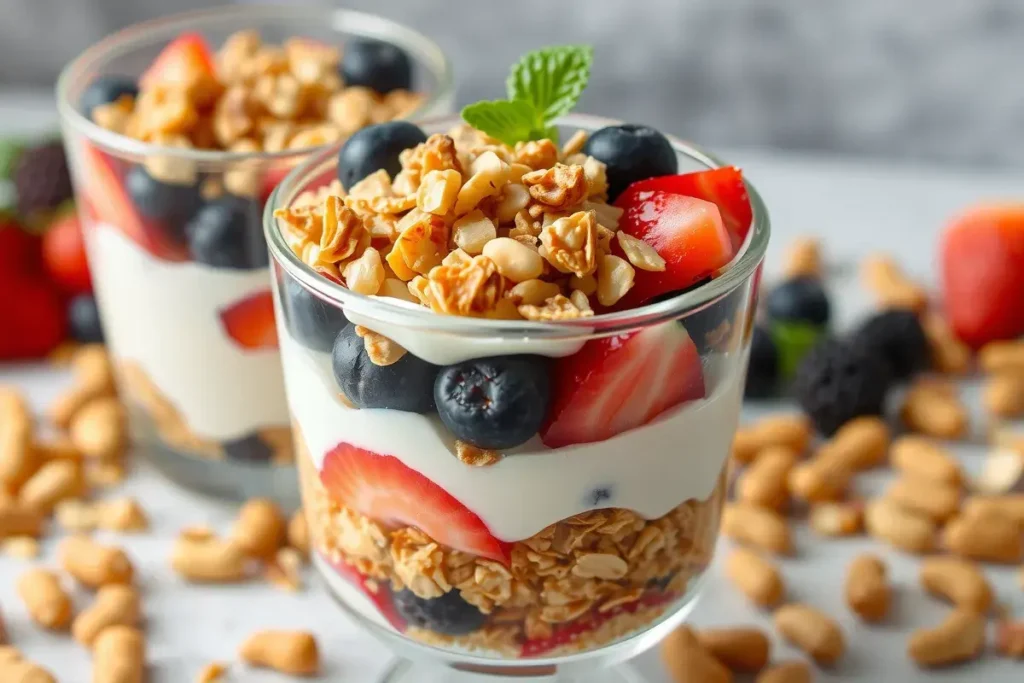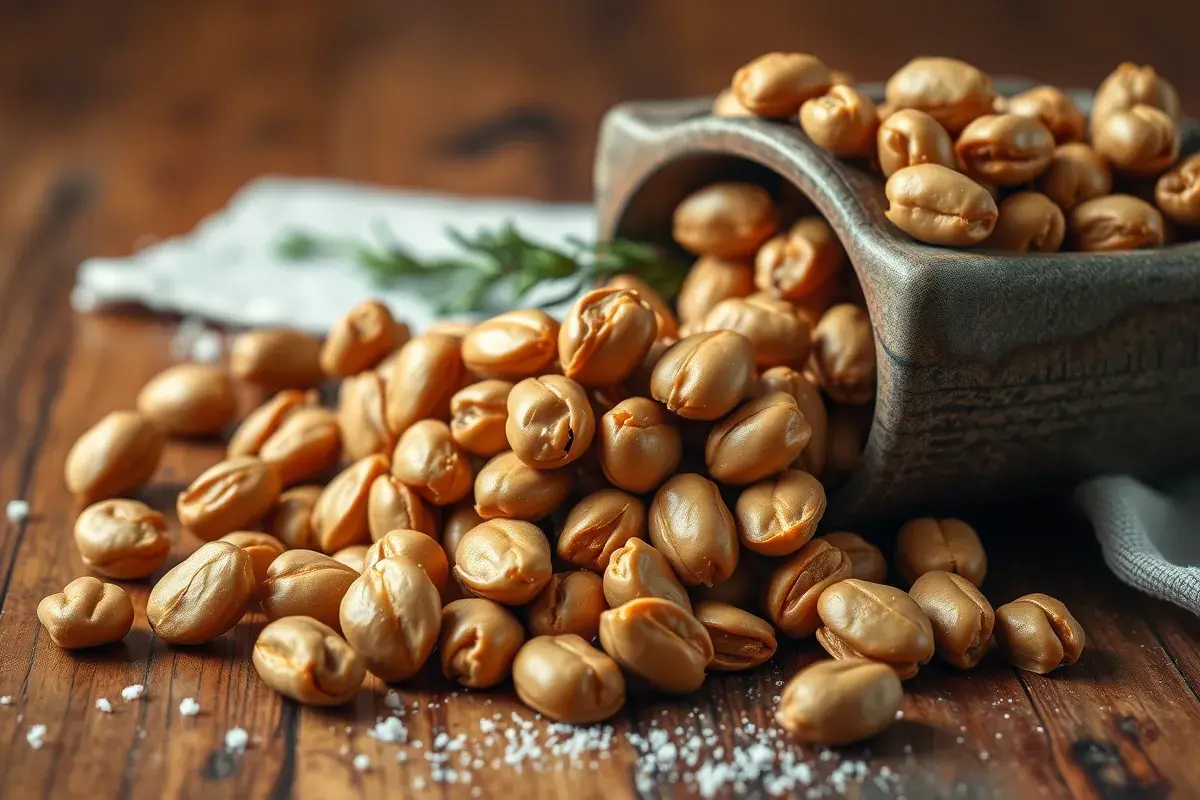Welcome to an in-depth look at toffee peanuts. If you love sweet snacks, you’ve likely tasted these crunchy delights at least once. However, have you ever wondered what sets toffee peanuts apart? In today’s fast-paced world, people seek quick bites that combine both sweet and savory flavors. By pairing roasted peanuts with a caramelized sugar coating, these candy-coated peanuts offer a delightful texture and a buttery toffee flavor that can brighten any moment.
Numerous global cuisines feature sugar-coated nuts. Still, butter toffee nuts shine because of their balanced taste. Toffee itself dates to 19th-century England, but the tradition of coating peanuts with sugar is centuries older. Therefore, this delicious snack isn’t just another sugary treat; it reflects the melding of various confectionery styles from around the world. Additionally, it delivers instant energy and can enliven gatherings of all kinds. Whether you’re hosting a fun party or enjoying a quiet evening at home, keeping a stash of toffee peanuts nearby can make life that much sweeter.
Furthermore, these caramelized peanuts serve many purposes. You can eat them straight from the bag, sprinkle them on desserts, or even mix them into savory dishes for a sweet crunch. At the same time, they’re easy to share and perfect for events like movie nights, picnics, or casual get-togethers. As you delve into this thorough guide, you’ll learn about their beginnings, explore creative serving ideas, understand their nutritional profile, and pick up tips for choosing the best quality. By the end, you’ll be ready to fully appreciate the crisp, sugary world of toffee peanuts.
The Origins of Toffee Peanuts (Caramelized Peanuts)
Every enticing snack has a fascinating backstory, and toffee peanuts are no exception. Their journey involves the evolution of candy-making methods in various regions and the popularization of peanuts as a staple ingredient.
Early Candy-Making Traditions for Candy-Coated Peanuts
In 19th-century England, confectioners experimented with sugar, molasses, and treacle to craft early toffee. Meanwhile, peanuts have an ancient heritage in Mesoamerica. Soon enough, candy artisans realized that roasted peanuts and molten sugar form a perfect marriage of taste and texture.
Global Influence on Butter Toffee Nuts
Although commonly linked with Western candy shops, variations of sugar-coated nuts appear worldwide. In Asia, candied nuts might include sesame seeds or ginger; in the Middle East, nuts are often glazed with sweet syrups. Nonetheless, the crisp shell and rich notes of toffee peanuts set them apart, combining British toffee-making techniques with the universal appeal of roasted nuts.
Traditional vs. Modern Production of Sweet Peanuts
Historically, small batches were prepared by toasting peanuts and drizzling them with boiling sugar over open flames. This labor-intensive process demanded precise timing. Modern facilities, in contrast, use large tumblers that coat peanuts uniformly. This streamlining has made caramelized peanuts more accessible, found in supermarkets, candy stores, and online retailers across the globe.

Basic Ingredients That Make Butter Toffee Peanuts Irresistible
To craft these toffee-coated nuts, you need four key elements: peanuts, sugar, a fat source (often butter), and salt. Small tweaks to each can dramatically change flavor and texture.
Peanuts: The Backbone of Caramelized Peanuts
Peanuts provide the nutty foundation, and roasted peanuts enhance the flavor even more. Their affordability also makes toffee peanuts a favorite over pricier nuts like almonds or cashews.
Sugar in Toffee-Coated Peanuts
Sugar is paramount for achieving a hard, brittle shell through caramelization. White sugar offers a clean sweetness, while brown sugar introduces molasses undertones. Some confectioners mix both to deepen the flavor profile.
Butter or Other Fats for Candy-Coated Peanuts
Butter lends the indulgent mouthfeel we associate with premium toffee. Certain manufacturers opt for margarine or vegetable oils to reduce costs or cater to dietary needs. Nonetheless, many enthusiasts swear by the fuller taste of genuine butter.
Salt: The Secret to Perfectly Balanced Sweet Peanuts
Salt may seem minor, yet it underscores sweetness and rounds out the overall flavor. Even lightly salted peanuts can elevate these sugary nuts, creating a harmonious sweet-and-salty experience.
Additional Flavor Enhancements
- Extracts and Spices: Vanilla, cinnamon, or cocoa can add bold flavors.
- Coatings: Cornstarch or powdered sugar may be used for extra polish.
- Preservatives: Commercial brands often include small amounts of stabilizers to extend shelf life.
Crunchy and Sweet: The Science Behind Candy-Coated Toffee Peanuts
Taking a bite of these butter toffee nuts reveals a crisp exterior courtesy of sugar crystallization. Understanding these chemical reactions offers insight into why they differ from typical sugary treats.
Caramelization vs. Maillard Reaction in Toffee Peanuts
When sugar heats past approximately 300°F (148°C), it caramelizes, gaining deep flavor and color. Meanwhile, peanuts contain proteins and natural sugars that undergo the Maillard reaction during roasting. Together, these processes yield the complex, toffee-like taste of candy-coated peanuts.
Hard Crack vs. Soft Ball Stage for Caramelized Nuts
Candy-making temperatures dictate texture. Toffee peanuts require the sugar to reach a hard crack stage (300–310°F or 148–154°C) for that brittle snap. If removed earlier, around the soft ball stage, the coating turns chewy instead of crisp.
Cooling for Crispness in Toffee-Coated Nuts
After peanuts tumble in molten sugar, quick cooling is crucial. Artisans or machines rapidly reduce the temperature, preventing moisture absorption and cementing the shell’s signature crunch.
Why These Sweet Peanuts Stand Out
Candied varieties like honey-roasted peanuts don’t always reach the hard crack stage. By contrast, toffee peanuts do, forming a firm, toffee-like surface. Adding butter or a similar fat amplifies the richness, differentiating toffee-coated nuts from other sugared snacks.
Popular Variations of Toffee Peanuts
Candy-making often involves playful innovation, and caramelized peanuts are no different. Certain variations focus on unique tastes, while others emphasize visual or textural elements.
Classic Toffee Peanuts
The tried-and-true recipe blends salted peanuts, white sugar, and butter for an authentic crunchy sweetness. This version remains a staple in candy shops and supermarkets.
Chocolate-Dipped Candy-Coated Peanuts
For chocolate fans, some producers encase the coated peanuts in a chocolate shell. This extra layer intensifies flavor and seals in freshness, adding a gourmet flair to familiar treats.
Spiced or Savory Blends of Butter Toffee Nuts
Beyond sweetness, some variants include cinnamon, nutmeg, chili powder, or paprika. These subtle or bold additions result in a sweet-and-spicy or even sweet-and-smoky combination that can surprise and delight adventurous eaters.
Festive Sprinkles on Caramelized Peanuts
Holiday or themed sprinkles might adorn sweet peanuts during festive seasons. Colorful toppings make them visually appealing, perfect for parties or gift baskets.
Gourmet Finishes for Candy-Coated Peanuts
High-end producers sometimes infuse gourmet salts, exotic spices, or specialty sweeteners like maple syrup. These premium batches can cost more but reward connoisseurs with a uniquely refined taste experience.
How to Enjoy Toffee Peanuts in Everyday Life

Although they’re often labeled as treats, these toffee-coated nuts easily fit into routine meals and snacks. Here are some innovative ways to bring them into your day-to-day life:
Toppings and Mix-Ins with Candy-Coated Peanuts
- Ice Cream: Crumble them over a scoop of vanilla or chocolate ice cream.
- Baked Goods: Decorate cupcakes or brownies with chopped, caramelized peanuts.
- Parfaits: Layer yogurt, fruit, granola, and a sprinkle of sweet peanuts for an energy-packed breakfast.
Sweet-and-Savory Fusion with Butter Toffee Nuts
- Salads: A handful on a spinach-and-fruit salad adds crunch and sweetness.
- Stir-Fries: Introduce them for a pop of sweet flavor against spicy or salty sauces.
- Grain Bowls: Place toffee peanuts atop a teriyaki or curry rice bowl for added texture.
Convenient Snack Packs of Caramelized Peanuts
Busy lifestyles call for quick snacks. Pre-portion small bags of these nuts, mixed with dried fruits or seeds. This reduces impulse munching and provides a balanced burst of energy.
Gift and Party Ideas with Sweet Peanuts
Wrap a selection of toffee-coated nuts in decorative bags or boxes, pairing them with specialty teas or chocolates. These homemade gift baskets convey a personal touch. At gatherings, set out bowls of candy-coated peanuts for guests to enjoy without fuss.
Post-Workout Treat with Candy-Coated Peanuts
Although mainly a dessert, peanuts do contain protein. A small portion can serve as a reward for mild workouts, providing both quick energy and a hint of protein for recovery.
Health and Nutritional Insights for Caramelized Peanuts
Undeniably a sugary indulgence, these toffee-coated nuts can still offer certain nutritional positives. However, moderation is key.
Protein and Fats in Toffee-Coated Nuts
Peanuts supply plant-based protein and beneficial monounsaturated fats, useful for supporting muscle repair and overall well-being. In limited doses, they can fit into a balanced diet.
Sugar and Calorie Considerations for Butter Toffee Peanuts
To produce the crunchy shell, significant sugar is heated and caramelized. This elevates carbohydrate and calorie counts. Overconsumption can cause spikes in blood sugar or excess caloric intake. Hence, portion control is advised.
Fiber and Micronutrients in Sweet Peanuts
Peanuts also contain dietary fiber, aiding digestion. They include valuable vitamins (E, B vitamins) and minerals (magnesium, phosphorus). Though the sugar coating dilutes these advantages somewhat, they remain present in the peanut core.
Portion Control for Candy-Coated Peanuts
- Measure Servings: Scoop small amounts rather than snacking from a large container.
- Combine Wisely: Mix them with unsalted seeds and dried fruit for a varied snack.
- Occasional Enjoyment: Treat them like a dessert rather than a daily staple.
With mindful consumption, toffee peanuts can offer a sweet treat without completely derailing a healthy eating plan.
Buying and Storing Toffee Peanuts
Ensuring top-tier quality and proper storage can enhance your experience with these crunchy candies. Below are pointers to guide you.
Choosing Quality Caramelized Peanuts
- Ingredient Lists: Seek products made with real butter, minimal preservatives, and quality nuts.
- Packaging: Opt for sealed, undamaged packages to keep out moisture and contaminants.
- Brand Reputation: Established candy brands generally uphold higher ingredient and safety standards.
- Sample First: If accessible, taste-test a small portion before buying in bulk.
Optimal Storage for Candy-Coated Nuts
- Cool, Dry Space: Heat and humidity can soften the sugary shell. Keep them away from direct sunlight.
- Airtight Containers: Once opened, transfer leftover butter toffee nuts into sealed jars or zip-lock bags.
- Avoid Refrigeration: Fridge storage might introduce moisture, compromising crunch. Room temperature is ideal.
- Check Expiration Dates: Follow the “best by” date to enjoy them at their peak.
Buying in Bulk for Sweet Peanuts
If you’re a devoted fan, purchasing large quantities can be economical. Just ensure you can consume them before they lose their crisp quality. Even prime storage methods can’t preserve them forever.
Reviving Stale Butter Toffee Peanuts
If your caramelized peanuts become soft, a quick toast in the oven at a low heat may restore some crispness. Keep an eye on them, as high temperatures could burn the sugary exterior. However, proper storage remains the best preventative measure.
FAQ: All About Toffee Peanuts
What are butter toffee peanuts?
They’re a variation that emphasizes real butter in the caramelization process. This accentuates a rich, creamy finish for each peanut, making butter toffee peanuts particularly decadent.
What is the difference between British toffee and American toffee?
British toffee typically incorporates brown sugar or treacle, resulting in molasses undertones. American toffee often features white sugar and may include more butter. Consequently, British toffee can taste more robust, while American toffee tends to be lighter and clearer in sweetness. Both types can be used to craft candy-coated peanuts.
How long do toffee peanuts last?
When unopened and stored in a cool, dry place, they can remain fresh for up to six months. After opening, plan to consume them within four to six weeks for optimal flavor and crunch. Always heed the “best by” date.
What are candy-covered peanuts called?
They go by various names, including toffee peanuts, chocolate peanuts, peanut clusters, or even part of “bridge mix” when combined with other confections. The distinct feature of caramelized peanuts is the brittle sugar shell that sets them apart as a sweet-and-salty snack.
These toffee peanuts bring together sweet toffee flavor and roasted peanut goodness, resulting in a highly addictive treat. Learning about their history, different styles, health factors, and storage can help you appreciate each crunchy morsel. Whether you opt for classic butter toffee nuts, spiced versions, or gourmet artisanal offerings, these confections promise a sensational taste. Consider keeping a small supply in your pantry or gifting them to friends for a memorable sweet-and-salty experience—one that proves just how universal the appeal of candy-coated peanuts truly is.

